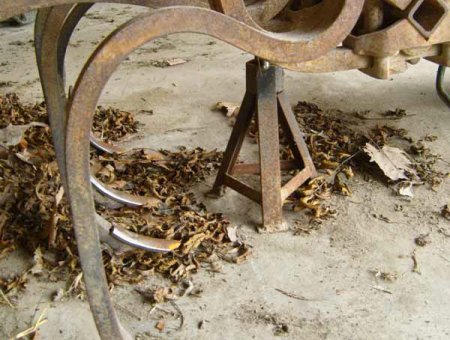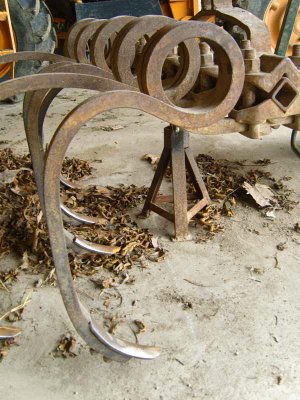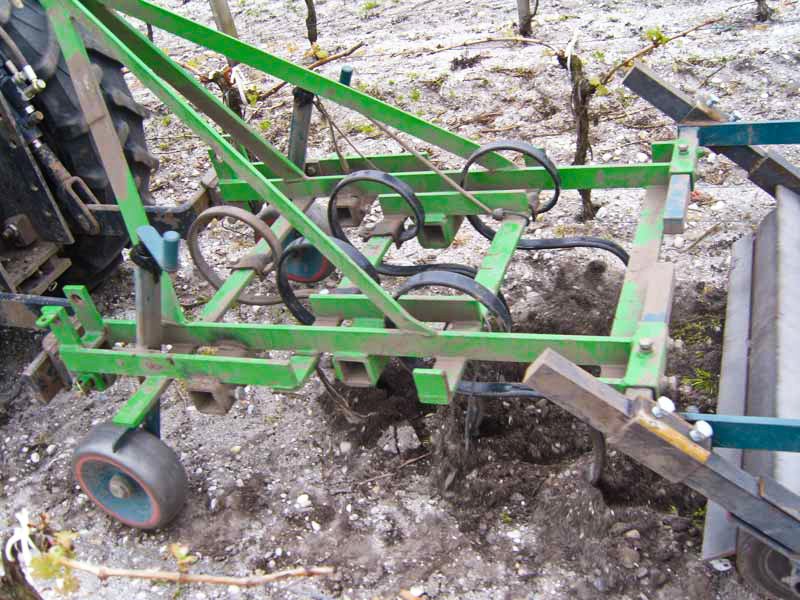Tine tool
Vineyard tine tools, which originated in the field, offer a mechanical alternative to traditional weed control and enable shallow compaction. They consist of a frame with shanks fitted with a variety of tines (rigid, multi-subsoiler, semi-rigid and vibrating) adapted to different work objectives. The shares used include scarifying shares for deep furrows and extirpating shares for cutting and lifting roots.
The setting of these tools includes adjustment of the horizontality and depth of work, enabling operations to be carried out at depths of 5 to 25 cm as required.
The setting of these tools includes adjustment of the horizontality and depth of work, enabling operations to be carried out at depths of 5 to 25 cm as required.

Work objective
These tools are originally used in arable farming, where they are used for ploughing, and therefore have an impact on soil structure. In winegrowing, they provide an alternative to traditional ploughing. They are mainly used as a mechanical weeding method, but can also be used for shallow decompaction.Components of tine tools
Tine tools are made up of a chassis or frame on which stanchions are mounted. Each stanchion has a wear part which can have different shapes depending on the purpose of the work to be carried out - this is the ploughshare.There are different types of tine.
Rigid tines
These are generally straight except for the slightly curved lower end. They have a spring at the point where they are attached to the frame, which allows the tine to escape if resistance is too strong. This type of machine creates break lines in the soil, without over-refining the soil or sorting it (no clods are brought to the surface).The working width of a tine is around 20 centimetres and the working depth is considerable.
Multi-subsoilers
The best-known machine in this category is the Actisol. The working part of the tine has a central point made up of a square and two wide fins. They work to a width of around 40 centimetres, and have good penetrating power even in very compacted soil. Their action is twofold: they act on the structure of the soil, which they break up, and they act on weeds by hoeing vigorously. Their working depth is often determined by a cage roller.Flexible tines
Semi-rigid tines

These tines are generally made of steel with a square cross-section of 20 to 25 mm, and are often referred to as pigtails. Their flexibility is limited, but they are effective both longitudinally and laterally.
This flexibility makes it possible to maintain vibrations, and the working width of the tine is 15 to 20 cm. This type of device is often used in wine-growing because the tines are resistant and can retract if they come into contact with stones.
Vibrating tines

These are made from thin, flat steel. The tine forms an "S" and has a pinch at its base to regidify it.
This tool is used as an alternative to summer ploughing, but its action is weak in compact soil or on weeds with a strong root system.
Main types of coulter
There are two types of coulter used in ploughshares:
- Scarifying ploughshares: these are generally narrow (30 to 50 mm) and fairly small in size, with a reinforced point at both ends, making them reversible. They are often called "melon ribs". They are designed to work deeply, forming deep, narrow furrows.
- Digging ploughshares: these generally consist of a triangular point fitted with two lateral fins with sharp edges. These ploughshares work at a depth of just a few centimetres, cutting the roots and then lifting them up. At their widest they measure between 17 and 25 cm.
Setting and using tine tools
Setting
The first adjustment to be made is to ensure that the tool is horizontal.Depth is adjusted using the cage roller at the rear of the tool or wheels at the front.
Use
Tine tools are generally used for ploughing over or pseudo-ploughing. They can work to depths of between 5 and 25 cm, depending on the type of stanchion and tine.The type of stanchion, the shape and number of tines and the working speed will need to be modified to suit the work to be carried out - burying, crumbling or levelling.












